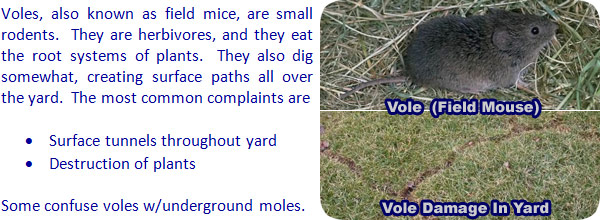- info@wildlifeanimalcontrol.com
Call us for help in your town
Wildlife Control Education
How to Catch a Vole

Need vole removal in your hometown? We service over 500 USA locations! Click here to hire us in your town and check prices - updated for year 2020.
Intercepting voles to disrupt them from nesting and breeding, doing damage to property and food supplies may require different strategies based on where one finds them and on what scale these common field mice are nesting.
If you are a town or city dweller who has found a vole or two in your home, then you will easily remedy the intrusion by catching them in a cardboard box and resettling your uninvited guests elsewhere. However, an infestation of three or more in your home might require an extermination program.
In order to prevent overrun of the home, once infestation has occurred, extermination is the only viable option. House cats will drive the voles into hiding, but not out of your home. Cats will sleep during the day. Although voles are nocturnal, they maneuver throughout the day and can nest and forage outside the house to avoid the tabbies, while building a thriving community indoors. A sizeable vole colony may be beyond the trap and release option, especially if you work away from home or the house is empty during a large part of the day.
Voles breed on a prolific scale, producing one to five litters per female per year. Litter size varies; but, remembers, females reach reproductive maturity at two weeks old. Doing the math would indicate to the wise that acting early to catch and release a single vole found at home will prevent having to kill voles later, in order to exterminate a population that is growing out of control, and to resolve a potentially unmanageable and devastating problem.
Keep in mind that the lone vole in your house came from somewhere else, a place where there are more voles to take its place. That is why vigilance and being knowledgeable about what kind of bait works (chunky peanut butter!) to trap a vole without poison is so important. If you trap the scout, and release it far away from the host colony, then you send a warning to them that your home is not a good target.
Catching the lone outlaw should be done with safety in mind. If you see the vole out in the open and can put a cardboard box over it, then be sure that before you act be wearing gloves. A frightened vole can bite. Vole bites carry infectious disease that reacts quickly in the human bloodstream. After you are sure the vole is secured under the box is ready to quickly right side the box by turning it quickly on its side trapping the vole between the box and another vertical surface so that you can scoop the box up under it and put a lid on the box.
Once the vole is secured inside the box, add some grass cutting or greens to the box and allow the vole to calm down before taking it for a drive out into an area far from other residences. If you release the vole back into your own yard, it will return and get inside your home the way it did on previous raids. Voles are territorial around a one quarter acre radius from their nesting grounds. Once they are removed to an uninhabited area two to three miles away, there is little chance of their returning.
If you cannot trap the vole in your home out in the open spaces because it is hiding from you, then place cage traps on the approach walls to the hiding place. Cage traps are about the size of a card tray and have a trip plate in the center. Consult with extermination professional or a knowledgeable assistant at your local hardware supply store where rodent control products are sold.
Bait the opening below the door of the cage to entice the vole. Then, farther inside the trap smear some peanut butter and sesame seeds for it to eat. Just beyond the trap plate, place more tasty bait so that the vole will have to step on the trap plate. The weight of the vole will spring the door shut behind it. If you have a house cat and you are gone during the day remember that Tabby will likely torment the trapped vole while you are away!
More in-detail how-to vole removal articles:
Information about vole trapping - analysis and methods for how to trap.
Information about how to kill a vole - with poison or other methods.
Information about how to keep voles away - prevention techniques.
Information about vole repellent - analysis of types and effectiveness.
This site is intended to provide information about how to catch a vole, so that you can make an informed decision
if you need to deal with a vole problem. This site provides many vole capture articles and strategies, if
you wish to attempt to solve the problem yourself. If you are unable to do so, which is likely with many
cases of vole removal, please go to the home page and click the USA map, where I have wildlife removal experts
listed in over 500 cites and towns, who can properly help you with your nuisance vole.
Click here to
read more about how to get rid of voles.

















